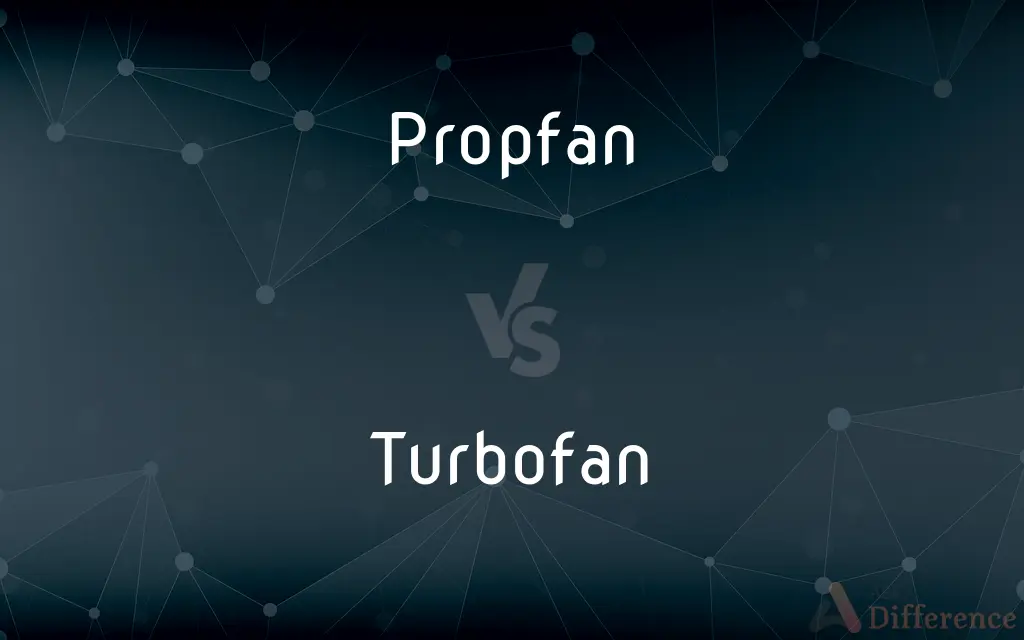Propfan vs. Turbofan — What's the Difference?
By Tayyaba Rehman & Urooj Arif — Updated on May 4, 2024
Propfans combine turbofan efficiency with propeller speed advantages, offering fuel savings; turbofans, meanwhile, excel in quieter operations and wide application in commercial jets.

Difference Between Propfan and Turbofan
Table of Contents
ADVERTISEMENT
Key Differences
Propfans are designed to operate efficiently at higher speeds and use less fuel due to their open rotor design, which resembles a combination of a turbofan and a propeller. On the other hand, turbofans are enclosed engines that primarily focus on high efficiency at cruising speeds typical of commercial airliners.
The architecture of a propfan exposes its blades to the airstream, leading to potentially higher noise levels and operational limits at very high speeds. Whereas turbofans encase their fan blades within a duct, significantly reducing noise and allowing for smoother airflow at various speeds.
Propfans are generally considered more economical in terms of fuel consumption, especially on short to medium-haul flights, due to their aerodynamic efficiency. In contrast, turbofans are preferred for long-haul flights due to their ability to maintain efficiency over long distances and at high altitudes.
The development of propfan technology was driven by the need for more fuel-efficient engines during times of high fuel prices. On the other hand, turbofans have been developed and refined over decades, focusing on reliability, noise reduction, and adaptability to different types of aircraft.
Maintenance for propfans can be more complex and frequent due to their exposed components and mechanical stresses. Turbofans, however, benefit from a more contained structure that protects critical components and generally offers lower maintenance demands.
ADVERTISEMENT
Comparison Chart
Design
Open rotor, exposed blades
Enclosed rotor, ducted fan blades
Noise Level
Higher, due to blade exposure
Lower, due to enclosed design
Fuel Efficiency
Higher at lower speeds
Optimized for high-altitude cruise
Maintenance
More complex due to exposure
Generally simpler, less frequent
Preferred Use
Short to medium-haul flights
Long-haul commercial flights
Compare with Definitions
Propfan
A type of aircraft engine featuring an open rotor that combines elements of both turboprop and turbofan technologies.
The airline tested a propfan engine to evaluate potential fuel savings.
Turbofan
Provides high efficiency and is suited for long-range flights.
Turbofan engines are the backbone of the international air travel industry.
Propfan
Offers enhanced fuel efficiency at certain speeds.
Propfan designs excel in scenarios where fuel economy is prioritized.
Turbofan
A type of jet engine where air is drawn into a fan and split into two streams.
Most commercial jets are powered by turbofan engines for efficient high-altitude travel.
Propfan
Known for its distinctive appearance with visible blades.
Propfan engines can be immediately recognized by their large, unshrouded propellers.
Turbofan
Features complex internal mechanisms that improve thrust.
The turbofan's sophisticated design allows for optimal performance at cruising altitude.
Propfan
Used primarily in experimental or niche applications.
Propfans were explored extensively during the 1980s fuel crises.
Turbofan
Known for its quiet operation compared to other jet engines.
Turbofan engines contribute significantly to noise reduction in modern aircraft.
Propfan
Generally louder than fully shrouded turbofan engines.
The noise level of the propfan is a considerable factor in its limited adoption.
Turbofan
Widely used in both commercial and military aircraft.
The versatility of turbofan engines makes them ideal for various types of aircraft.
Propfan
A propfan, also called an open rotor engine, or unducted fan (as opposed to a ducted fan), is a type of aircraft engine related in concept to both the turboprop and turbofan, but distinct from both. The design is intended to offer the speed and performance of a turbofan, with the fuel economy of a turboprop.
Turbofan
The turbofan or fanjet is a type of airbreathing jet engine that is widely used in aircraft propulsion. The word "turbofan" is a portmanteau of "turbine" and "fan": the turbo portion refers to a gas turbine engine which achieves mechanical energy from combustion, and the fan, a ducted fan that uses the mechanical energy from the gas turbine to accelerate air rearwards.
Propfan
(aviation) A modified turbofan jet engine with the propeller outside the engine duct of an aircraft.
Turbofan
A turbojet engine in which a fan supplements the total thrust by forcing air directly into the hot turbine exhaust.
Turbofan
An aircraft in which a turbofan is used. In both senses also called fanjet.
Turbofan
(aviation) A turbojet engine having a (typically ducted) fan that forces air directly into the hot exhaust and obtains a portion of the thrust from the turbojet and a portion from the turbojet section.
Turbofan
Jet engine in which a turbine drives air to the burner
Common Curiosities
Can propfans be used on commercial passenger aircraft?
Propfans are generally used in experimental or specialized aircraft due to their noise levels and operational characteristics, making them less common in typical commercial passenger aircraft.
What are the main design differences between a propfan and a turbofan?
Propfans have an open rotor design with visible blades, enhancing aerodynamic efficiency at certain speeds, while turbofans feature a ducted fan that helps reduce noise and allows smoother operation at higher speeds.
What are the environmental impacts of using propfans compared to turbofans?
Propfans typically offer better fuel efficiency, which can lead to reduced carbon emissions compared to some turbofans, especially in specific operational scenarios like shorter flights.
How do the costs of operating a propfan compare to those of a turbofan?
The lower fuel consumption of propfans can lead to cost savings in fuel expenses; however, potential higher maintenance costs and limited applicability might offset these savings.
Are there any specific safety concerns associated with propfans?
The open rotor design of propfans might pose additional risks in terms of blade integrity and object ingestion compared to the enclosed design of turbofans.
What advancements have been made in turbofan technology recently?
Recent advancements in turbofan technology include improvements in noise reduction, fuel efficiency, and thrust capabilities through enhanced fan blade designs and more efficient combustion systems.
How do turbofans manage noise reduction so effectively?
Turbofans reduce noise through several mechanisms, including sound-absorbing materials in the nacelle, advanced fan blade designs that minimize noise, and the ducted fan that helps contain and dissipate sound waves.
What maintenance challenges are unique to propfans?
Propfans face unique maintenance challenges such as managing the wear and tear on exposed blades and dealing with the mechanical stresses of an open rotor system.
How does the fuel type affect the efficiency of propfans and turbofans?
Both engine types can be affected by fuel type, with developments in alternative fuels like biofuels and synthetic fuels possibly enhancing their efficiency and reducing environmental impacts.
What types of aircraft typically use propfan engines?
Propfan engines are most commonly found in experimental, military, or specialized cargo aircraft where fuel efficiency and cost-effectiveness are highly prioritized over passenger comfort.
How do operating altitudes affect the performance of propfans versus turbofans?
Propfans are optimized for lower to mid-altitude flights where their design maximizes aerodynamic efficiency, while turbofans perform best at high altitudes common in commercial jet travel.
What are the future prospects for propfan engines in aviation?
The future of propfan engines depends on advancements that reduce noise levels and enhance operational safety, potentially increasing their applicability in commercial and cargo transport sectors.
How do advancements in material science impact propfan and turbofan development?
Advances in material science, including the development of stronger, lighter materials, have significant impacts on both propfan and turbofan engines, improving their efficiency, durability, and overall performance.
What role do propfans and turbofans play in reducing aviation's carbon footprint?
Both engines contribute to carbon reduction strategies; propfans through direct fuel efficiency and turbofans through technological advancements that optimize fuel use and reduce emissions.
Can turbofan engines operate efficiently at low speeds and altitudes like propfans?
Turbofan engines are less efficient at lower speeds and altitudes compared to propfans due to their design and operational characteristics geared towards high-speed, high-altitude flights.
Share Your Discovery

Previous Comparison
Protest vs. Remonstrate
Next Comparison
Photographic vs. PhotographyAuthor Spotlight
Written by
Tayyaba RehmanTayyaba Rehman is a distinguished writer, currently serving as a primary contributor to askdifference.com. As a researcher in semantics and etymology, Tayyaba's passion for the complexity of languages and their distinctions has found a perfect home on the platform. Tayyaba delves into the intricacies of language, distinguishing between commonly confused words and phrases, thereby providing clarity for readers worldwide.
Co-written by
Urooj ArifUrooj is a skilled content writer at Ask Difference, known for her exceptional ability to simplify complex topics into engaging and informative content. With a passion for research and a flair for clear, concise writing, she consistently delivers articles that resonate with our diverse audience.
















































